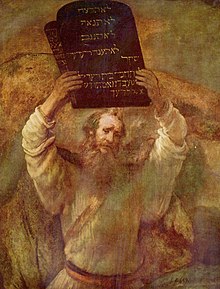This article needs additional citations for verification. (November 2010) |
Abrahamic religions believe in the Mosaic covenant (named after Moses), also known as the Sinaitic covenant (after the biblical Mount Sinai), which refers to a covenant between the Israelite tribes and God, including their proselytes, not limited to the ten commandments, nor the event when they were given, but including the entirety of laws that their patriarch Moses delivered from God in the five books of Torah.[1][2]

According to the biblical narrative, the Book of the Covenant, recording all the commands of the LORD, was written by Moses in the desert and read to the people, and to seal the covenant, the blood of sacrificial oxen was then sprinkled, half on an altar and half on the people.[3]
Historical-critical scholarship
editThe concept of a covenant began long before the biblical era, specifically the beginnings of Israel. According to George E. Mendenhall, covenants were originally established as legal customs and then later were replicated in the field of religion. These covenants were created on the basis of an oath, a promise between two parties followed by performance. Engaging in an oath implied that the more powerful party would ensure that the other received proper punishment if it were to default. In the case of religion, the god(s) would be carrying out punishment. Such covenants assured that either blessings or curses be enacted in response to the circumstances.[4]
The covenant of the pieces between God and Abraham is not conditional. Future covenants between Israel and God would be conditional. This is clearly expressed in Deuteronomy 11:13–21, recited twice-daily as part of the foundational prayer, the Shema.
According to Mendenhall, the covenant was not just an idea, but actually a historical event. This event was the formation of the covenant community. Wandering the desert, the clans left Egypt following Moses. These people were all of different backgrounds, containing no status in any social community. With all these circumstances they formed their own community by a covenant whose texts turned into the Decalogue (Ten Commandments). The Israelites did not bind themselves to Moses as their leader though and Moses was not a part of the covenant. The Israelites followed the form of the suzerainty treaty, a particular type of covenant common in the Near East and were bound to obey stipulations that were set by God, not Moses.[4]
In addition to Mendenhall's input and perspective, M. Weinfeld argues that there are two forms of covenants to have occurred throughout the Hebrew Bible: 1.) the obligatory type and 2.) the promissory type. These translate to a “political treaty” as evidenced by the Hittite Empire, and a "royal grant" as shown through the covenants tied to Abraham and David. A treaty entails a promise to the master by the vassal and ultimately protects the rights of the master. This consequently works in a manner that promotes future loyalty of the vassal since the suzerain had previously done favors for them. A grant, on the other hand, pertains to an obligation from the master to his servant, thus ensuring protection of the servant's rights.[5]
Judaism
editIn the Hebrew Bible, God established the Mosaic covenant with the Israelites after he saved them from slavery in Egypt in the book of Exodus. Moses led the Israelites to the promised land known as Canaan after which Joshua led them to its possession. The Mosaic covenant played a role in defining the Kingdom of Israel.
Rabbinic Judaism asserts that the Mosaic covenant was presented to the Jewish people and converts to Judaism and does not apply to Gentiles, with the notable exception of the Seven Laws of Noah which apply to all people.[citation needed]
Christianity
editThe Mosaic covenant or Law of Moses, which Christians generally call the "Old Covenant" in contrast to the New Covenant, has played an important role in the shaping of Christianity. It has been the source of serious dispute and contention seen in Jesus' expounding of the Law during his Sermon on the Mount, the circumcision controversy in early Christianity, and the Incident at Antioch which has led scholars to dispute the relationship between Paul of Tarsus and Judaism. The Book of Acts says that after the ascension of Jesus, Stephen, the first Christian martyr, was killed when he was accused of speaking against the Second Temple and the Mosaic Law.[7] Later, in Acts 15:1–21, the Council of Jerusalem addressed the circumcision controversy in early Christianity.
See also
editReferences
edit- ^ Jewish Encyclopedia: Proselyte: "...Isa. lvi. 3-6 enlarges on the attitude of those that joined themselves to Yhwh, "to minister to Him and love His name, to be His servant, keeping the Sabbath from profaning it, and laying hold on His covenant.""
- ^ Exodus 20:8: "thy stranger that is within thy gates"
- ^ Exodus 24:3–8
- ^ a b Mendenhall, George E. (1954). "Covenant Forms in Israelite Tradition". The Biblical Archaeologist. 17 (3). The American Schools of Oriental Research: 49–76. doi:10.2307/3209151. JSTOR 3209151. S2CID 166165146.
- ^ Weinfeld, M. (Apr–Jun 1970). "The Covenant of Grant in the Old Testament and in the Ancient near East". Journal of the American Oriental Society. 90 (2): 184–203. doi:10.2307/598135. JSTOR 598135.
- ^ Such as Hebrews 8:6 etc. See also Herbermann, Charles, ed. (1913). . Catholic Encyclopedia. New York: Robert Appleton Company.: "The central thought of the entire Epistle is the doctrine of the Person of Christ and His Divine mediatorial office.... There He now exercises forever His priestly office of mediator as our Advocate with the Father (vii, 24 sq.)."
- ^ Acts 6:8–14